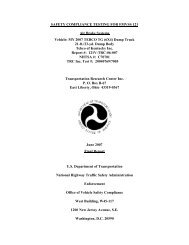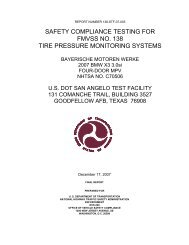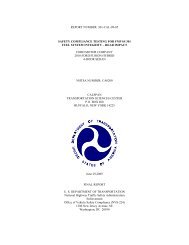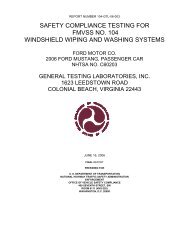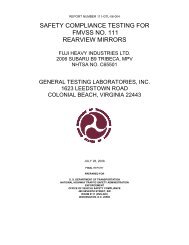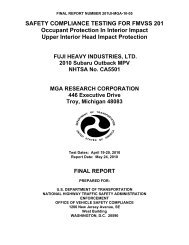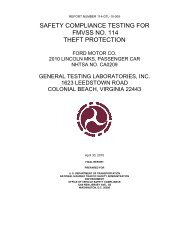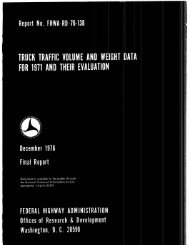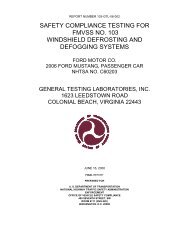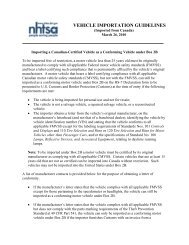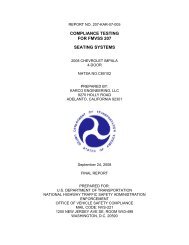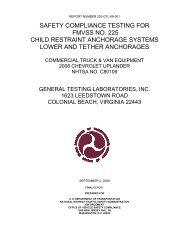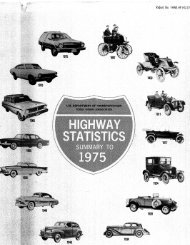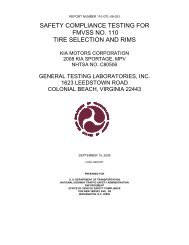report number: 305-cal-08-05 safety compliance testing for fmvss ...
report number: 305-cal-08-05 safety compliance testing for fmvss ...
report number: 305-cal-08-05 safety compliance testing for fmvss ...
Create successful ePaper yourself
Turn your PDF publications into a flip-book with our unique Google optimized e-Paper software.
REPORT NUMBER: <strong>3<strong>05</strong></strong>-CAL-<strong>08</strong>-<strong>05</strong><br />
SAFETY COMPLIANCE TESTING FOR FMVSS <strong>3<strong>05</strong></strong><br />
ELECTRIC POWERED VEHICLES: ELECTROLYTE SPILLAGE<br />
AND ELECTRICAL SHOCK PROTECTION<br />
FORD MOTOR COMPANY<br />
2010 FORD FUSION HYBRID<br />
4-DOOR SEDAN<br />
NHTSA NUMBER: CA0200<br />
CALSPAN<br />
TRANSPORTATION SCIENCES CENTER<br />
P.O. BOX 400<br />
BUFFALO, NEW YORK 14225<br />
June 29,2009<br />
FINAL REPORT<br />
U. S. DEPARTMENT OF TRANSPORTATION<br />
National Highway Traffic Safety Administration<br />
En<strong>for</strong>cement<br />
Office of Vehicle Safety Compliance (NVS-224)<br />
1200 New Jersey Avenue, SE<br />
Washington, DC 2<strong>05</strong>90
This Final Test Report was prepared <strong>for</strong> the U.S. Department of Transportation, National Highway Traffic Safety<br />
Administration, under Contract No. DTNH22-06-C-00031. This publication is distributed by the U.S. Department of<br />
Transportation, National Highway Traffic Safety Administration, in the interest of in<strong>for</strong>mation exchange. The opinions,<br />
findings and conclusions expressed in this publication are those of the author(s) and not necessarily those of the Department<br />
of Transportation or the National Highway Traffic Safety Administration. The United States Government assumes no<br />
liability <strong>for</strong> its contents or use thereof. If trade or manufactures' names or products are mentioned, it is only because they are<br />
considered essential to the object of the publication and should not be construed as an endorsement. The United States<br />
Government does not endorse products or manufacturers.<br />
Prepared By:<br />
Vincent Paolini, Project Engineer<br />
Approved By:<br />
David J. Travale, Program Manager<br />
Transportation Sciences Center<br />
Approval Date:<br />
FINAL REPORT ACCEPTANCE BY:<br />
Accepted By:<br />
Acceptance Date:<br />
ii<br />
8878-F<strong>3<strong>05</strong></strong>-<strong>05</strong>
TECHNICAL REPORT STANDARD TITLE PAGE<br />
1. Report No. 2. Government Accession No. 3. Recipient's Catalog No.<br />
<strong>3<strong>05</strong></strong>-CAL-<strong>08</strong>-<strong>05</strong><br />
4. Title and Subtitle 5. Report Date<br />
Final Report of FMVSS <strong>3<strong>05</strong></strong> Compliance Rear Impact Testing of a June 29,2009<br />
2010 Ford Fusion Hybrid 4-door Sedan<br />
NHTSA No.: CA0200<br />
6. Per<strong>for</strong>ming Organization Code<br />
CAL<br />
7. Author(s) 8. Per<strong>for</strong>ming Organization Report No.<br />
Vincent Paolini, Project Engineer<br />
David J. Travale, Program Manager<br />
9. Per<strong>for</strong>ming Organization Name and Address 10. Work Unit No.<br />
Calspan<br />
Transportation Sciences Center<br />
P.O. Box 400<br />
Buffalo, New York 14225<br />
12. Sponsoring Agency Name and Address<br />
U.S. Department of Transportation<br />
National Highway Traffic Safety Administration<br />
Office of Vehicle Safety Compliance<br />
11. Contract or Grant No.<br />
DTNH22-06-C-00031<br />
13. Type of Report and Period Covered<br />
Final Report,<br />
June 2009<br />
1200 New Jersey Avenue, SE 14. Sponsoring Agency Code<br />
Washington, D.C. 2<strong>05</strong>90<br />
NVS-220<br />
15. Supplementary Notes<br />
16. Abstract<br />
Compliance tests were conducted on the subject 2010 Ford Fusion Hybrid 4-door Sedan in accordance with the<br />
specifications of the Office of Vehicle Safety Compliance Test Procedure No. TP-<strong>3<strong>05</strong></strong>-00 <strong>for</strong> the determination of FMVSS<br />
<strong>3<strong>05</strong></strong> <strong>compliance</strong>. Test failures identified were as follows:<br />
The test vehicle appeared to comply with all requirements of FMVSS <strong>3<strong>05</strong></strong> "Electric Powered Vehicles: Electrolyte Spillage<br />
and Electri<strong>cal</strong> Shock Protection."<br />
17. Key Words<br />
Compliance Testing<br />
Safety Engineering<br />
FMVSS <strong>3<strong>05</strong></strong><br />
18. Distribution Statement<br />
Copies of this <strong>report</strong> are available from:<br />
National Highway Traffic Safety Administration<br />
Techni<strong>cal</strong> Reference Division (TIS) (NPO-230)<br />
1200 New Jersey Avenue, SE<br />
Washington, D.C. 2<strong>05</strong>90<br />
Telephone No. (202) 366-4946<br />
19. Security Classification of Report 20. Security Classification of Page 21. No. of Pages 22. Price<br />
UNCLASSIFIED UNCLASSIFIED 55<br />
iii<br />
8878-F<strong>3<strong>05</strong></strong>-<strong>05</strong>
TABLE OF CONTENTS<br />
Section<br />
Page No.<br />
1 PURPOSE AND TEST PROCEDURE 1-1<br />
2 COMPLIANCE TEST RESULTS SUMMARY 2-1<br />
3 SUMMARY OF TEST RESULTS 3-1<br />
Data Sheet 1 - Test Vehicle Specifications 3-2<br />
Data Sheet 2 – Pre-Test Data 3-3<br />
Data Sheet 3 - Moving De<strong>for</strong>mable Barrier (MDB) Data 3-6<br />
Data Sheet 4 - Pre-Impact Electri<strong>cal</strong> Isolation Measurements & Calculations 3-7<br />
Data Sheet 5 - High Speed Camera Locations and Data Summary 3-8<br />
Data Sheet 6 – Post-Test Data 3-9<br />
Data Sheet 7 – Post-Impact Electri<strong>cal</strong> Isolation Measurements & Calculations 3-11<br />
Data Sheet 8 – FMVSS 301 Rollover Data 3-12<br />
Data Sheet 9 – FMVSS <strong>3<strong>05</strong></strong> Rollover Data 3-13<br />
APPENDIX A PHOTOGRAPHS A-1<br />
iv<br />
8878-F<strong>3<strong>05</strong></strong>-<strong>05</strong>
SECTION 1<br />
PURPOSE AND TEST PROCEDURE<br />
This rear impact test is part of the FMVSS <strong>3<strong>05</strong></strong> Compliance Test Program sponsored by the National Highway<br />
Traffic Safety Administration (NHTSA) under Contract No. DTNH22-06-C-00031. The purpose of this test was to determine<br />
if the subject vehicle, a 2010 Ford Fusion Hybrid 4-door Sedan, meets the per<strong>for</strong>mance requirements of FMVSS No. <strong>3<strong>05</strong></strong><br />
“Electric Powered Vehicles: Electrolyte Spillage and Electri<strong>cal</strong> Shock Protection.” The test was conducted in accordance<br />
with the Office of Vehicle Safety Compliance's Laboratory Test Procedure (TP-<strong>3<strong>05</strong></strong>D-00, dated December 29, 20<strong>05</strong>).<br />
1-1 8878-F<strong>3<strong>05</strong></strong>-<strong>05</strong>
SECTION 2<br />
COMPLIANCE TEST RESULTS SUMMARY<br />
A 1876 kg 2010 Ford Fusion Hybrid 4-door Sedan was impacted from the rear by an 1797 kg moving barrier at a<br />
velocity of 79.8 kph (49.6 mph). The test was per<strong>for</strong>med by Calspan Corporation on June 29,2009.<br />
The test vehicle was equipped with a 66.2 liter fuel tank which was filled to 92 percent capacity with stoddard fluid prior<br />
to impact. Additional ballast (30 kg) was secured in the vehicle cargo area. Two ballast Part 572E 50th percentile male<br />
Anthropomorphic Test Device (ATD) were placed in the front occupant seating positions.<br />
The crash event was recorded by three high-speed cameras and one real-time camera. High-speed camera locations and<br />
other pertinent camera in<strong>for</strong>mation are found on page 3-8 of this <strong>report</strong>. Pre- and post-test photographs of the vehicle can be<br />
found in Appendix A.<br />
There was no fuel system fluid or propulsion battery electrolyte spillage following the impact or during any portion of<br />
the static rollover test. The vehicle appeared to comply with all the requirements of FMVSS <strong>3<strong>05</strong></strong> "Electric Powered Vehicles:<br />
Electrolyte Spillage and Electri<strong>cal</strong> Shock Protection."<br />
2-1 8878-F<strong>3<strong>05</strong></strong>-<strong>05</strong>
SECTION 3<br />
SUMMARY OF TEST RESULTS<br />
3-1 8878-F<strong>3<strong>05</strong></strong>-<strong>05</strong>
DATA SHEET 1<br />
TEST VEHICLE SPECIFICATIONS<br />
TEST VEHICLE INFORMATION:<br />
Year/Make/Model/Body Style:<br />
2010 Ford Fusion Hybrid 4-door Sedan<br />
Vehicle Body Color: Black NHTSA Number: CA0200<br />
Engine Data: 4 Cylinders; - CID; 2.5 Liters; - cc<br />
Transmission: CV Speed; - Manual; X Automatic; - Overdrive<br />
Final Drive: T - Rear Wheel Drive; X Front Wheel Drive; - Four Wheel Drive<br />
MAJOR TEST VEHICLE OPTIONS:<br />
X AC; X Pwr Steering; X Power Brakes; X Power Locks; X Power Seats<br />
X ABS; X Tilt Wheel; - Stab Control X Traction Control X Anti-Theft<br />
DEALER AND DELIVERY INFORMATION:<br />
Date Received: 5/21/09 ; Odometer Reading 77 km<br />
Selling Dealer:<br />
West Herr Ford<br />
Dealer Address: 5025 Camp Rd Hamburg, New York 14075<br />
DATA FROM VEHICLE'S CERTIFICATION LABEL:<br />
Vehicle Manufacturer:<br />
Ford Motor Company<br />
Vehicle Build Date: 04/09<br />
VIN::<br />
3FADP0L38AR132742<br />
GVWR: 2132 kg; GAWR: 1130 kg FRONT; 1002 kg REAR<br />
DATA FROM VEHICLE'S TIRE LABEL AND SIDEWALL:<br />
Location of Tire Placard:<br />
Type of Spare Tire:<br />
Rear Trunk<br />
Temporary<br />
Maximum Tire Pressure (sidewall - kPa) 300 300<br />
Cold Pressure (tire placard - kPa) – test pressure 230 230<br />
Recommended Tire Size (tire placard) P225/50R17 P225/50R17<br />
Vehicle Tire Size with load index & speed symbol P225/50R17 93V P225/50R17 93V<br />
Tire Manufacturer Michelin Michelin<br />
Tire Name Energy Energy<br />
Treadwear, Traction, Temperature 440 A A 440 A A<br />
VEHICLE CAPACITY DATA:<br />
Front<br />
Type of Front Seats: - Bench; X Bucket; - Split Bench<br />
Number of Occupants: 2 Front; 3 Rear; 5 Total<br />
Vehicle Capacity Weight (VCW) = 385 kg<br />
No. of Occupants x 68.04 kg = 340 kg<br />
Rated Cargo/Luggage Weight (RCLW) = 45 kg<br />
ELECTRIC VEHICLE PROPULSION SYSTEM:<br />
Electric Vehicle Type: - Electric; X Electric/Hybrid<br />
Propulsion Battery Type:<br />
Nominal Voltage: 230 V<br />
Location of Automatic Propulsion Battery Disconnect<br />
NiMH Traction Battery<br />
Interior of Traction Battery System<br />
Rear<br />
Auxiliary Battery Type:<br />
N/A<br />
3-2 8878-F<strong>3<strong>05</strong></strong>-<strong>05</strong>
DATA SHEET 2<br />
PRE-TEST DATA<br />
WEIGHT OF TEST VEHICLE AS RECEIVED FROM DEALER (with maximum fluids)= UDW:<br />
Left Side (kg) Right Side (kg) Ratio (%) Total (kg)<br />
Front = 499 510 59.6 1009.0<br />
Rear = 362 321 40.4 683.0<br />
Total Delivered Weight (UDW) = 1692.0<br />
CALCULATION OF VEHICLE'S TARGET TEST WEIGHT:<br />
Total Delivered Weight (UDW) = 1692.0 kg<br />
Rated Cargo/Luggage Weight (RCLW) = 45 kg<br />
Weight of 2 p.572E Dummies @ 78 each = 156 kg<br />
TARGET TEST WEIGHT = 1893.0 kg<br />
WEIGHT OF TEST VEHICLE WITH TWO DUMMIES AND 28.0 KG OF CARGO WEIGHT:<br />
Left Side (kg) Right Side (kg) Ratio (%) Total (kg)<br />
Front = 558 559 59.5 1117.0<br />
Rear = 394 365 40.5 759.0<br />
Total Vehicle Test Weight (ATW) = 1876.0<br />
Weight of Ballast Secured in Vehicle 1 = 30 kg Ballast Type Lead Shot Bags<br />
Method of securing Ballast:Compartment Placement<br />
Components Removed <strong>for</strong> Weight Reduction:None<br />
VEHICLE ATTITUDE (all dimension in millimeters):<br />
Left Front Right Front Left Rear Right Rear CG²<br />
AS DELIVERED: 722 733 722 720 1101<br />
AS TESTED: 703 713 709 712 1104<br />
Vehicle's Wheel Base: 2729 mm<br />
¹Ballast weight does not include the weight of instrumentation, on-board cameras and data acquisition system<br />
²Rearward of the front axle centerline.<br />
VEHICLE PRE-TEST WIDTH AND IMPACT OFFSET MEASUREMENT:<br />
Vehicle Width at Widest Point: 1822 mm Location: Rear Axle<br />
Centerline offset <strong>for</strong> impact line: 1275 mm<br />
Filler neck side (left/right )<br />
Left<br />
3-3 8878-F<strong>3<strong>05</strong></strong>-<strong>05</strong>
DATA SHEET 2 (continued)<br />
PRE-TEST DATA<br />
Vehicle: 2010 Ford Fusion Hybrid 4-door Sedan<br />
NHTSA No. CA0200<br />
DEGREES<br />
Nominal Design Riding Position <strong>for</strong> adjustable driver<br />
and passenger seat backs. Please describe how to<br />
position the inclinometer to measure the seat back<br />
angle. Include description of the location of the<br />
adjustment latch detent, if applicable.<br />
UPRIGHT POSITION<br />
SEAT CUSHION<br />
SEAT BACK<br />
INCLINOMETER<br />
ADJUSTER<br />
LEFT SIDE VIEW<br />
FRONT SEAT ASSEMBLY<br />
Seat back angle <strong>for</strong> driver's seat: 10.8<br />
Measurement instructions: Seat back was set to 10.8 degrees on head restraint post with sill level<br />
Seat back angle <strong>for</strong> passenger's seat: 10.8<br />
Measurement instructions:<br />
Seat back was set to 10.8 degrees on head restraint post with sill level<br />
2. SEAT FORE AND AFT POSITIONING:<br />
Positioning of the driver's seat: Full <strong>for</strong>ward – Full rear = Travel 296 mm. Seat was positioned at 147 mm<br />
on face of the cushion while in full down.<br />
Positioning of the passenger's seat:<br />
Full <strong>for</strong>ward – Full rear = Travel 250 mm. Seat was positioned at 125 mm<br />
on face of the cushion while in full down.<br />
3. FUEL TANK CAPACITY DATA:<br />
3.1 A. "Usable Capacity" of the standard equipment fuel tank is 66.2 liters<br />
B. "Usable Capacity" of the optional equipment fuel tank is - liters<br />
C. "Usable Capacity" of the vehicle(s) used <strong>for</strong> certification<br />
<strong>testing</strong> to requirements of FMVSS 301 =<br />
60.9 to 62.2 liters<br />
3.2 Actual Amount of Stoddard solvent added to vehicle <strong>for</strong> test = 61.6 liters<br />
3.3 Is vehicle equipped with electric fuel pump Yes- X ; No- -<br />
If YES, explain the vehicle operating conditions under which the fuel pump will pump fuel.<br />
With ignition turned “ON”<br />
4. STEERING COLUMN ADJUSTMENTS:<br />
Steering wheel and column adjustments are made so that the steering wheel hub is at the geometric center of the locus it<br />
describes when it is moved through its full range of driving positions. If the tested vehicle has any of these adjustments,<br />
does your company use any specific procedures to determine the geometric center.<br />
Operational Instructions:<br />
Telescopic travel was 30 mm; centered at 15 mm. Tilt wheel was centered at<br />
Center of loci: face of wheel was set at 22.7 degrees<br />
3-4 8878-F<strong>3<strong>05</strong></strong>-<strong>05</strong>
DATA SHEET 1 (continued)<br />
GENERAL TEST VEHICLE PARAMETER DATA<br />
Vehicle: 2010 Ford Fusion Hybrid 4-door Sedan<br />
NHTSA No. CA0200<br />
5. SEAT BELT UPPER ANCHORAGE:<br />
Nominal design riding position:<br />
4 detents available – set at detent 1 with 0 as uppermost<br />
6. PROPULSION BATTERY SYSTEM DATA (COTR SUPPLIED):<br />
Electrolyte Fluid Type:<br />
Alkaline<br />
Electrolyte Fluid Specific Gravity:<br />
1.3 grams / cc<br />
Electrolyte Fluid Kinematic Viscosity: 1.75 centistokes at 25ºC<br />
Electrolyte Fluid Color<br />
Clear Liquid<br />
Propulsion Battery Coolant Type,<br />
Air<br />
Color and Specific Gravity:<br />
N/A<br />
Location of Battery Modules: X In Occupant Compartment - Outside Occupant Compartment<br />
7. PROPULSION BATTERY STATE OF CHARGE<br />
Maximum State of Charge:<br />
290 – 330 volts<br />
Test Voltage (≥95% of maximum) -<br />
OR<br />
Range of Normal Operating Voltage: -<br />
Test Voltage (within range) -<br />
8. Details of Chassis Ground Points and Locations:<br />
By removing the rear seat, located behind the seats trim panel located between the rear door opening and rear seat, a<br />
Grounding weld nut is found.<br />
9. Details of Propulsion Battery Components:<br />
The main battery is located behind the rear passenger seat. Propulsion unit located in engine compartment.<br />
10. Comments:<br />
None<br />
3-5 8878-F<strong>3<strong>05</strong></strong>-<strong>05</strong>
DATA SHEET 3<br />
MOVING DEFORMABLE BARRIER (MDB) DATA<br />
Vehicle: 2010 Ford Fusion Hybrid 4-door Sedan<br />
NHTSA No. CA0200<br />
MDB FACE MANUFACTURER AND SERIAL NUMBER:<br />
Plascore Block Numbers: 139B10<strong>08</strong> 124B0309 Unit Number: A0409029<br />
MDB DETAILS:<br />
Overall Width of Framework Carriage = 1250 millimeters<br />
Overall Length of MDB (incl. honeycomb impact face) = 4120 millimeters<br />
Wheelbase of Framework Carriage = 2591 millimeters<br />
Tread of Framework Carriage (Front & Rear) = 1875 millimeters<br />
C.G. Location Rearward of Front Axle = 1139 millimeters<br />
MDB WEIGHT:<br />
Left Front = 357.0 kg Left Rear = 323.0 kg<br />
Right Front = 404.0 kg Right Rear = 273.5 kg<br />
TOTAL FRONT = 761.0 kg TOTAL REAR = 596.5 kg<br />
TOTAL MDB WEIGHT = 1357.5 kg<br />
Tires (Mfr, line, size): -<br />
TIRE PRESSURE:<br />
Left Front = 207 kPa Left Rear = 207 kPa<br />
Right Front = 207 kPa Right Rear = 207 kPa<br />
Brake Abort System (Yes/No)<br />
Yes<br />
Date of Last Calibration: 06/07<br />
3-6 8878-F<strong>3<strong>05</strong></strong>-<strong>05</strong>
DATA SHEET 4<br />
PRE-IMPACT ELECTRICAL ISOLATION MEASUREMENTS & CALCULATIONS<br />
Vehicle: 2010 Ford Fusion Hybrid 4-door Sedan<br />
NHTSA No. CA0200<br />
VOLTMETER INFORMATION:<br />
Make: Fluke Model: 87 S/N: 65280327<br />
Internal Resistance Value: 0.12 MΩ<br />
Resolution: .001 V<br />
Last Calibration Date: 4/10/2009<br />
Propulsion Battery Voltage : (ready to drive position) V b = 260.5 V<br />
Propulsion Battery to Vehicle Chassis: V 1 = 230 V<br />
Propulsion Battery to Vehicle Chassis: V 2 = 230 V<br />
Propulsion Battery to Vehicle Chassis Across Known Resistor: R o = 120k Ω<br />
Propulsion Battery to Vehicle Chassis with R o installed: V 1 ’ = 0.06 V<br />
Propulsion Battery to Vehicle Chassis: with R o installed: V 2 ’ = 0.<strong>05</strong> V<br />
ELECTRICAL ISOLATION MEASUREMENTS:<br />
R i1 : 919760 kΩ R i1 = R o *(1+V 2 /V 1 )*[(V 1 -V 1 ’)/V 1 ’]<br />
R i2 : 1103760 kΩ R i2 = R o *(1+V 1 /V 2 )*[(V 2 -V 2 ’)/V 2 ’]<br />
R i 919760 kΩ Lesser value of R i1 and R i2<br />
R i /V b 3530749 Ω/V Electri<strong>cal</strong> Isolation Value<br />
Is the Electri<strong>cal</strong> Isolation Value ≥ 500 Ω/V<br />
If NO - Failure<br />
Yes/No<br />
YES<br />
Comments:<br />
None<br />
3-7 8878-F<strong>3<strong>05</strong></strong>-<strong>05</strong>
DATA SHEET 5<br />
HIGH SPEED CAMERA LOCATIONS AND DATA SUMMARY<br />
Vehicle: 2010 Ford Fusion Hybrid 4-door Sedan<br />
NHTSA No. CA0200<br />
Camera<br />
No.<br />
View<br />
Coordinates (millimeters)<br />
X* Y* Z*<br />
Angle<br />
(deg.)<br />
Lens<br />
(mm)<br />
Film Speed<br />
(fps)<br />
1 Left Side View 7345 1195 1094 -3 24 1000<br />
2 Real-Time Camera - - - - - 30<br />
3 Overhead View 0 4<strong>05</strong> 4880 -90 20 1000<br />
4 Right Side View 7850 1345 959 -5 24 1000<br />
* Reference (from point of impact); all measurements accurate to within ±6 mm.<br />
X = (Impact Point) + Forward<br />
Y = (Impact Point) + To Right<br />
Z = (Ground Level) + Down<br />
3-8 8878-F<strong>3<strong>05</strong></strong>-<strong>05</strong>
DATA SHEET 6<br />
POST-TEST DATA<br />
Vehicle: 2010 Ford Fusion Hybrid 4-door Sedan<br />
NHTSA No. CA0200<br />
REQUIRED IMPACT VELOCITY RANGE:: 78.5 to 80.1 km/h<br />
ACTUAL IMPACT VELOCITY WITHIN 1.5 M OF IMPACT PLANE:<br />
Trap No. 1 = 79.8 km/h Trap No. 2 = 79.8 km/h<br />
Average Impact Speed = 79.8 km/h<br />
WELDING ROD IMPACT POINT:<br />
-10 Verti<strong>cal</strong> distance from target center (+ is above) Tolerance: ±40 mm<br />
-30 Horizontal distance from target center (+ is right) Tolerance: ±50 mm<br />
STODDARD SOLVENT SPILLAGE MEASUREMENT:<br />
A. Front impact until vehicle motion ceases -<br />
Actual = 0 g Maximum Allowable = 28 g<br />
B. For 5 minute period after vehicle motion ceases -<br />
Actual = 0 g Maximum Allowable = 28 g<br />
C. For next 25 minutes -<br />
Actual = 0 g/minute Maximum Allowable = 28 g/minute<br />
D. Provide Spillage Details:<br />
None<br />
ELECTROLYTE SPILLAGE MEASUREMENT:<br />
Is propulsion battery electrolyte spillage visible in occupant compartment - Yes (fail) X No<br />
For 30 minutes until vehicle motion ceases -<br />
Actual = 0 L Maximum Allowable = 5 L<br />
Provide Spillage Details:<br />
None<br />
3-9 8878-F<strong>3<strong>05</strong></strong>-<strong>05</strong>
DATA SHEET 6<br />
POST-TEST DATA (Continued)<br />
Vehicle: 2010 Ford Fusion Hybrid 4-door Sedan<br />
NHTSA No. CA0200<br />
POST TEST SEAT DATA<br />
LOCATION SEAT MOVEMENT (mm) SEAT BACK FAILURE<br />
P1 (Left Front) 46 rearward None – Reclined during impact<br />
P2 (Right Front) 0 None – Reclined during impact<br />
POST TEST ATD CONTACT DATA<br />
LOCATION Position 1 (Driver) Position 2 (Passenger)<br />
Head Rear of head to head restraint Rear of head to head restraint<br />
Chest No Contact No Contact<br />
Abdomen No Contact No Contact<br />
Left Knee No Contact No Contact<br />
Right Knee No Contact No Contact<br />
VEHICLE DIMENSIONS:<br />
Vehicle length:<br />
Left Side Centerline Right Side<br />
Pre-Test 4715 4846 4715<br />
Post-Test 4023 4125 4226<br />
Crush 692 721 489<br />
Vehicle Wheel Base:<br />
Left Side Right Side<br />
Pre-Test 2725 2732<br />
Post-Test 2622 2743<br />
Crush 103 -11<br />
3-10 8878-F<strong>3<strong>05</strong></strong>-<strong>05</strong>
DATA SHEET 7<br />
POST-IMPACT ELECTRICAL ISOLATION MEASUREMENTS & CALCULATIONS<br />
Vehicle: 2010 Ford Fusion Hybrid 4-door Sedan<br />
NHTSA No. CA0200<br />
VOLTMETER INFORMATION:<br />
Make: Fluke Model: 87 S/N: 65280327<br />
Internal Impedance Value 0.12 MΩ<br />
Normal Propulsion Battery Voltage (V b ): 5.69 V<br />
ELECTICAL ISOLATION MEASUREMENTS<br />
V 1 = 3.0 V Impact Time: 2 minutes 00 seconds<br />
V 2 = 3.5 V Impact Time: 2 minutes 00 seconds<br />
V 1 ’ = .006 V Impact Time: 2 minutes 00 seconds<br />
V 2 ’ = .001 V Impact Time: 2 minutes 00 seconds<br />
R i1 = 129740 Ω Impact R i1= R o*(1+V 2/V 1)*[(V 1-V 1’)/V 1’] Time: 2 minutes 00 seconds<br />
R i2 = 779777 Ω Impact R i2= R o*(1+V 1/V 2)*[(V 2-V 2’)/V 2’] Time: 2 minutes 00 seconds<br />
R i = 129740 Ω Impact Lesser value of R i1 and R i2 Time: 2 minutes 00 seconds<br />
R i /V b = 22761404 Ω Impact Time: 2 minutes 00 seconds<br />
Is the measured Electri<strong>cal</strong> Isolation Value ≥ 500 Ω/V X Yes - No (Fail)<br />
PROPULSION BATTERY SYSTEM COMPONENTS<br />
Describe Propulsion Battery Module movement within occupant compartment:<br />
None<br />
Has the Propulsion Battery Module moved within the occupant compartment - Yes(Fail) X No<br />
Describe intrusion of an outside Propulsion Battery Component into the occupant compartment:<br />
None<br />
Has an outside Propulsion Battery Component intruded into the occupant compartment - Yes(Fail) X No<br />
Is Propulsion Battery electrolyte spillage visible in the occupant compartment - Yes(Fail) X No<br />
3-11 8878-F<strong>3<strong>05</strong></strong>-<strong>05</strong>
DATA SHEET 8<br />
FMVSS 301 ROLLOVER DATA<br />
Vehicle: 2010 Ford Fusion Hybrid 4-door Sedan<br />
NHTSA No.: CA0200<br />
I. DETERMINATION OF SOLVENT COLLECTION TIME PERIOD:<br />
Rollover<br />
Stage<br />
Rotation Time<br />
(spec. 1 -3 min)<br />
FMVSS 301<br />
Hold Time<br />
Total Time<br />
Next Whole<br />
Minute Interval<br />
0º - 90º 1 minutes <strong>08</strong> seconds 5 minutes 6 minutes 8 seconds 7 minutes<br />
90º - 180º 1 minutes 03 seconds 5 minutes 6 minutes 3 seconds 7 minutes<br />
180º-270º 1 minutes 04 seconds 5 minutes 6 minutes 4 seconds 7 minutes<br />
270º-360º 1 minutes 09 seconds 5 minutes 6 minutes 9 seconds 7 minutes<br />
II. FMVSS 301 REQUIREMENTS: (Maximum allowable solvent spillage):<br />
First 5 minutes from onset of rotation 6th min. 7th min. 8th min. (if required)<br />
142 g 28 g 28 g 28 g<br />
III. ACTUAL TEST VEHICLE SOLVENT SPILLAGE:<br />
Rollover<br />
Stage<br />
First 5 minutes<br />
from onset of rotation (g)<br />
6th min.<br />
(g)<br />
7th min.<br />
(g)<br />
8th min. (if required)<br />
(g)<br />
0º - 90º 0 0 0 N/A<br />
90º - 180º 0 0 0 N/A<br />
180º-270º 0 0 0 N/A<br />
270º-360º 0 0 0 N/A<br />
Note: Record spillage <strong>for</strong> whole minute intervals only as determined above.<br />
IV. SOLVENT SPILLAGE LOCATION(S):<br />
Rollover<br />
Stage<br />
Spillage Location<br />
0º - 90º None<br />
90º - 180º None<br />
180º-270º None<br />
270º-360º None<br />
3-12 8878-F<strong>3<strong>05</strong></strong>-<strong>05</strong>
DATA SHEET 9<br />
FMVSS <strong>3<strong>05</strong></strong> ROLLOVER DATA<br />
Vehicle: 2010 Ford Fusion Hybrid 4-door Sedan<br />
NHTSA No.: CA0200<br />
I. DETERMINATION OF PROPULSION BATTERY ELECTROLYTE COLLECTION TIME PERIOD:<br />
Rollover<br />
Stage<br />
Rotation Time<br />
(spec. 1 -3 min)<br />
FMVSS 301<br />
Hold Time<br />
Total Time<br />
Next Whole<br />
Minute Interval<br />
0º - 90º 1 minutes <strong>08</strong> seconds 5 minutes 6 minutes 8 seconds 7 minutes<br />
90º - 180º 1 minutes 03 seconds 5 minutes 6 minutes 3 seconds 7 minutes<br />
180º-270º 1 minutes 04 seconds 5 minutes 6 minutes 4 seconds 7 minutes<br />
270º-360º 1 minutes 09 seconds 5 minutes 6 minutes 9 seconds 7 minutes<br />
II. ACTUAL TEST VEHICLE PROPULSION BATTERY ELECTROLYTE SPILLAGE :<br />
Rollover<br />
Stage<br />
Propulsion Battery<br />
Electrolyte Spillage (L)<br />
Spillage Location<br />
0-90° 0 None<br />
90-180° 0 None<br />
180-270º 0 None<br />
270-360º 0 None<br />
Total Spillage: 0 L FMVSS <strong>3<strong>05</strong></strong> permits 5 L maximum<br />
Is the total spillage of Propulsion Battery electrolyte greater than 5.0 liters - YES (Fail) x NO<br />
Is Propulsion Battery electrolyte spillage visible in the occupant compartment - YES (Fail) x NO<br />
3-13 8878-F<strong>3<strong>05</strong></strong>-<strong>05</strong>
DATA SHEET 9<br />
FMVSS <strong>3<strong>05</strong></strong> ROLLOVER DATA (CONTINUED)<br />
Vehicle: 2010 Ford Fusion Hybrid 4-door Sedan<br />
NHTSA No.: CA0200<br />
III. ELECTRICAL ISOLATION MEASUREMENTS AND CALCULATIONS:<br />
VOLTMETER INFORMATION:<br />
Make: Fluke Model: 87 S/N: 65280327<br />
Internal Resistance Value (R O ) 0.12 MΩ<br />
Normal Propulsion Battery Voltage (V b ): 3.66 V<br />
R i1 = R o *(1+V 2 /V 1 )*[(V 1 -V 1 ’)/V 1 ’] R i2 = R o *(1+V 1 /V 2 )*[(V 2 -V 2 ’)/V 2 ’] Lesser value of R i1 and R i2<br />
Isolation Measurement<br />
(Volts)<br />
V 1 = 4<br />
V 2 = 4<br />
V 1 ’ = 0.002<br />
V 2 ’ = 0.001<br />
V 1 = 0.7<br />
V 2 = 3.1<br />
V 1 ’ = 0.002<br />
V 2 ’ = 0.001<br />
V 1 = 1.16<br />
V 2 = 3.1<br />
V 1 ’ = 0.002<br />
V 2 ’ = 0.001<br />
V 1 = 1.2<br />
V 2 = 2.72<br />
V 1 ’ = 0.002<br />
V 2 ’ = 0.001<br />
Stage<br />
R i1<br />
Ω<br />
R i2<br />
Ω<br />
R i<br />
Ω<br />
R i /V b<br />
Ω/V<br />
Time (min)<br />
Time (s)<br />
90° 479760 959760 479760 131<strong>08</strong>1967 1 <strong>08</strong><br />
180° 227349 455853 227349 62117096 1 03<br />
270° 255159 511035 255159 69715659 1 04<br />
360° 2348<strong>08</strong> 470227 2348<strong>08</strong> 64155191 1 09<br />
Is the measured Electri<strong>cal</strong> Isolation Value ≥ 500 Ω/V x YES - NO (Fail)<br />
COMMENTS:<br />
None<br />
3-14 8878-F<strong>3<strong>05</strong></strong>-<strong>05</strong>
APPENDIX A<br />
PHOTOGRAPHS<br />
A-1 8878-F<strong>3<strong>05</strong></strong>-<strong>05</strong>
TABLE OF PHOTOGRAPHS<br />
Figure Photograph Title Page<br />
Figure A- 1 VEHICLE PLACARD A- 4<br />
Figure A- 2 TIRE PLACARD A- 4<br />
Figure A- 3 LABELS RELATED TO ELECTRIC PROPULSION SYSTEM A- 5<br />
Figure A- 4 PRE-TEST TEST PORT INTERFACE PORT INSTALLATION VIEW A- 5<br />
Figure A- 5 PRE-TEST TEST DEVICE INSTALLATION VIEWS A- 6<br />
Figure A- 6 PRE-TEST CHASSIS GROUND POINT VIEWS A- 6<br />
Figure A- 7 PRE-TEST FRONT VIEW A- 7<br />
Figure A- 8 POST-TEST FRONT VIEW A- 7<br />
Figure A- 9 PRE-TEST LEFT SIDE VIEW A- 8<br />
Figure A- 10 POST-TEST LEFT SIDE VIEW A- 8<br />
Figure A- 11 PRE-TEST RIGHT SIDE VIEW A- 9<br />
Figure A- 12 POST-TEST RIGHT SIDE VIEW A- 9<br />
Figure A- 13 PRE-TEST LEFT FRONT THREE-QUARTER VIEW A- 10<br />
Figure A- 14 POST-TEST LEFT FRONT THREE-QUARTER VIEW A- 10<br />
Figure A- 15 PRE-TEST RIGHT FRONT THREE-QUARTER VIEW A- 11<br />
Figure A- 16 POST-TEST RIGHT FRONT THREE-QUARTER VIEW A- 11<br />
Figure A- 17 PRE-TEST LEFT REAR THREE-QUARTER VIEW A- 12<br />
Figure A- 18 POST-TEST LEFT REAR THREE-QUARTER VIEW A- 12<br />
Figure A- 19 PRE-TEST RIGHT REAR THREE-QUARTER VIEW A- 13<br />
Figure A- 20 POST-TEST RIGHT REAR THREE-QUARTER VIEW A- 13<br />
Figure A- 21 PRE-TEST REAR VIEW A- 14<br />
Figure A- 22 POST-TEST REAR VIEW A- 14<br />
Figure A- 23 PRE-TEST MDB FRONT VIEW A- 15<br />
Figure A- 24 POST-TEST MDB FRONT VIEW A- 15<br />
Figure A- 25 PRE-TEST MDB LEFT SIDE VIEW A- 16<br />
Figure A- 26 POST-TEST MDB LEFT SIDE VIEW A- 16<br />
Figure A- 27 PRE-TEST MDB RIGHT SIDE VIEW A- 17<br />
Figure A- 28 POST-TEST MDB RIGHT SIDE VIEW A- 17<br />
Figure A- 29 PRE-TEST MDB TOP VIEW A- 18<br />
Figure A- 30 POST-TEST MDB TOP VIEW A- 18<br />
Figure A- 31 PRE-TEST OVERHEAD VEHICLE AND MDB VIEW A- 19<br />
Figure A- 32 POST-TEST IMPACT TARGET VIEW A- 19<br />
Figure A- 33 PRE-TEST BATTERY PROPULSION MODULE(S) VIEW A- 20<br />
Figure A- 34 POST-TEST BATTERY PROPULSION MODULE(S) VIEW A- 20<br />
Figure A- 35 PRE-TEST PROPULSION BATTERY VIEW A- 21<br />
Figure A- 36 POST-TEST PROPULSION BATTERY VIEW A- 21<br />
Figure A- 37 PRE-TEST HIGH VOLTAGE INTERCONNECT VIEW A- 22<br />
Figure A- 38 POST-TEST HIGH VOLTAGE INTERCONNECT VIEW A- 22<br />
Figure A- 39 PRE-TEST BATTERY COMPARTMENT VIEW A- 23<br />
Figure A- 40 POST-TEST BATTERY COMPARTMENT VIEW A- 23<br />
Figure A- 41 PRE-TEST BATTERY VENTING SYSTEM VIEW A- 24<br />
Figure A- 42 POST-TEST BATTERY VENTING SYSTEM VIEW A- 24<br />
Figure A- 43 PRE-TEST ELECTRIC PROPULSION COMPONENT(S) VIEW A- 25<br />
Figure A- 44 POST-TEST ELECTRIC PROPULSION COMPONENT(S) VIEW A- 25<br />
Figure A- 45 PRE-TEST ELECTRIC PROPULSION DRIVE VIEW A- 26<br />
Figure A- 46 POST-TEST ELECTRIC PROPULSION DRIVE VIEW A- 26<br />
Figure A- 47 PRE-TEST VEHICLE PASSENGER COMPARTMENT VIEW A- 27<br />
Figure A- 48 POST-TEST VEHICLE PASSENGER COMPARTMENT VIEW A- 27<br />
A-2 8878-F<strong>3<strong>05</strong></strong>-<strong>05</strong>
TABLE OF PHOTOGRAPHS (Continued)<br />
Figure Photograph Title Page<br />
Figure A- 49 POST-TEST PROPULSION BATTERY ELECTROLYTE SPILLAGE LOCATION VIEW A- 28<br />
Figure A- 50 PRE-TEST FRONT UNDERBODY VIEW A- 29<br />
Figure A- 51 POST-TEST FRONT UNDERBODY VIEW A- 29<br />
Figure A- 52 PRE-TEST MID UNDERBODY VIEW A- 30<br />
Figure A- 53 POST-TEST MID UNDERBODY VIEW A- 30<br />
Figure A- 54 PRE-TEST REAR UNDERBODY VIEW A- 31<br />
Figure A- 55 POST-TEST REAR UNDERBODY VIEW A- 31<br />
Figure A- 56 PRE-TEST FUEL FILLER CAP VIEW A- 32<br />
Figure A- 57 POST-TEST FUEL FILLER CAP VIEW A- 32<br />
Figure A- 58 IMPACT VIEW A- 33<br />
Figure A- 59 ROLLOVER 90 VIEW HIGHLIGHTING PROPULSION BATTERY LOCATION A- 34<br />
Figure A- 60 ROLLOVER 180 VIEW HIGHLIGHTING PROPULSION BATTERY LOCATION A- 34<br />
Figure A- 61 ROLLOVER 270 VIEW HIGHLIGHTING PROPULSION BATTERY LOCATION A- 35<br />
Figure A- 62 ROLLOVER 360 VIEW HIGHLIGHTING PROPULSION BATTERY LOCATION A- 35<br />
A-3 8878-F<strong>3<strong>05</strong></strong>-<strong>05</strong>
Figure A-1: Vehicle Certification Placard<br />
Figure A-2: Vehicle Tire Placard<br />
A-4 8878-F<strong>3<strong>05</strong></strong>-<strong>05</strong>
Figure A-3: Vehicle Electric Propulsion System Label<br />
Figure A-4: Pre-Test Test Port Interface Port Installation View<br />
A-5 8878-F<strong>3<strong>05</strong></strong>-<strong>05</strong>
Photo Not Available<br />
Figure A-5: Pre-Test Test Device Installation Views<br />
Figure A-6: Pre-Test Chassis Ground Point View<br />
A-6 8878-F<strong>3<strong>05</strong></strong>-<strong>05</strong>
Figure A-7: Pre-Test Front View<br />
Figure A-8: Post-Test Front View<br />
A-7 8878-F<strong>3<strong>05</strong></strong>-<strong>05</strong>
Figure A-9: Pre-Test Left Side View<br />
Figure A-10: Post-Test Left Side View<br />
A-8 8878-F<strong>3<strong>05</strong></strong>-<strong>05</strong>
Figure A-11: Pre-Test Right Side View<br />
Figure A-12: Post-Test Right Side View<br />
A-9 8878-F<strong>3<strong>05</strong></strong>-<strong>05</strong>
Figure A-13: Pre-Test Left Front Three-Quarter View<br />
Figure A-14: Post-Test Left Front Three-Quarter View<br />
A-10 8878-F<strong>3<strong>05</strong></strong>-<strong>05</strong>
Figure A-15: Pre-Test Right Front Three-Quarter View<br />
Figure A-16: Post-Test Right Front Three-Quarter View<br />
A-11 8878-F<strong>3<strong>05</strong></strong>-<strong>05</strong>
Figure A-17: Pre-Test Left Rear Three-Quarter View<br />
Figure A-18: Post-Test Left Rear Three-Quarter View<br />
A-12 8878-F<strong>3<strong>05</strong></strong>-<strong>05</strong>
Figure A-19: Pre-Test Right Rear Three-Quarter View<br />
Figure A-20: Post-Test Right Rear Three-Quarter View<br />
A-13 8878-F<strong>3<strong>05</strong></strong>-<strong>05</strong>
Figure A-21: Pre-Test Rear View<br />
Figure A-22: Post-Test Rear View<br />
A-14 8878-F<strong>3<strong>05</strong></strong>-<strong>05</strong>
Figure A-23: Pre-Test MDB Front View<br />
Figure A-24: Post-Test MDB Front View<br />
A-15 8878-F<strong>3<strong>05</strong></strong>-<strong>05</strong>
Figure A-25: Pre-Test MDB Left Side View<br />
Figure A-26: Post-Test MDB Left Side View<br />
A-16 8878-F<strong>3<strong>05</strong></strong>-<strong>05</strong>
Figure A-27: Pre-Test MDB Right Side View<br />
Figure A-28: Post-Test MDB Right Side View<br />
A-17 8878-F<strong>3<strong>05</strong></strong>-<strong>05</strong>
Figure A-29: Pre-Test MDB Top View<br />
Figure A-30: Post-Test MDB Top View<br />
A-18 8878-F<strong>3<strong>05</strong></strong>-<strong>05</strong>
Figure A-31: Pre-Test Overhead Vehicle and MDB View<br />
Figure A-32: Post-Test Impact Target View<br />
A-19 8878-F<strong>3<strong>05</strong></strong>-<strong>05</strong>
Figure A-33: Pre-Test Battery Propulsion Module(S) View<br />
Figure A-34: Post-Test Battery Propulsion Module(S) View<br />
A-20 8878-F<strong>3<strong>05</strong></strong>-<strong>05</strong>
Figure A-35: Pre-Test Propulsion Battery View<br />
Photo Not Available<br />
Figure A-36: Post-Test Propulsion Battery View<br />
A-21 8878-F<strong>3<strong>05</strong></strong>-<strong>05</strong>
Figure A-37: Pre-Test High Voltage Interconnect View<br />
Figure A-38: Post-Test High Voltage Interconnect View<br />
A-22 8878-F<strong>3<strong>05</strong></strong>-<strong>05</strong>
Figure A-39: Pre-Test Battery Compartment View<br />
Figure A-40: Post-Test Battery Compartment View<br />
A-23 8878-F<strong>3<strong>05</strong></strong>-<strong>05</strong>
Figure A-41: Pre-Test Battery Venting System View<br />
Figure A-42: Post-Test Battery Venting System View<br />
A-24 8878-F<strong>3<strong>05</strong></strong>-<strong>05</strong>
Figure A-43: Pre-Test Electric Propulsion Component(S) View<br />
Figure A-44: Post-Test Electric Propulsion Component(S) View<br />
A-25 8878-F<strong>3<strong>05</strong></strong>-<strong>05</strong>
Figure A-45: Pre-Test Electric Propulsion Drive View<br />
Figure A-46: Post-Test Electric Propulsion Drive View<br />
A-26 8878-F<strong>3<strong>05</strong></strong>-<strong>05</strong>
Figure A-47: Pre-Test Vehicle Passenger Compartment View<br />
Figure A-48: Post-Test Vehicle Passenger Compartment View<br />
A-27 8878-F<strong>3<strong>05</strong></strong>-<strong>05</strong>
No Photograph Necessary<br />
Figure A-49: Post-Test Propulsion Battery Electrolyte Spillage Location View<br />
A-28 8878-F<strong>3<strong>05</strong></strong>-<strong>05</strong>
Figure A-50: Pre-Test Front Underbody View<br />
Figure A-51: Post-Test Front Underbody View<br />
A-29 8878-F<strong>3<strong>05</strong></strong>-<strong>05</strong>
Figure A-52: Pre-Test Mid Underbody View<br />
Figure A-53: Post-Test Mid Underbody View<br />
A-30 8878-F<strong>3<strong>05</strong></strong>-<strong>05</strong>
Figure A-54: Pre-Test Rear Underbody View<br />
Figure A-55: Post-Test Rear Underbody View<br />
A-31 8878-F<strong>3<strong>05</strong></strong>-<strong>05</strong>
Figure A-56: Pre-Test Fuel Filler Cap View<br />
Figure A-57: Post-Test Fuel Filler Cap View<br />
A-32 8878-F<strong>3<strong>05</strong></strong>-<strong>05</strong>
Figure A-58: Impact View<br />
A-33 8878-F<strong>3<strong>05</strong></strong>-<strong>05</strong>
No Photograph Necessary<br />
Figure A-59: Post-Test Passenger Contact to Airbag<br />
Figure A-60: Rollover View - 90°<br />
A-34 8878-F<strong>3<strong>05</strong></strong>-<strong>05</strong>
Figure A-61: Rollover View - 180°<br />
Figure A-62: Rollover View - 360°<br />
A-35 8878-F<strong>3<strong>05</strong></strong>-<strong>05</strong>



